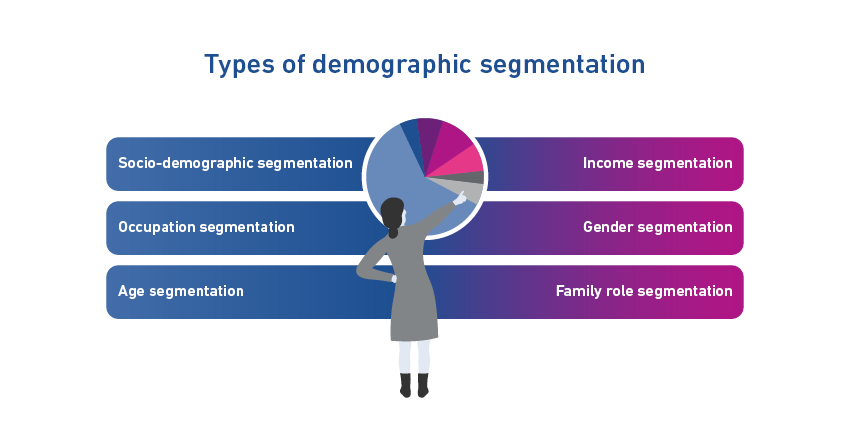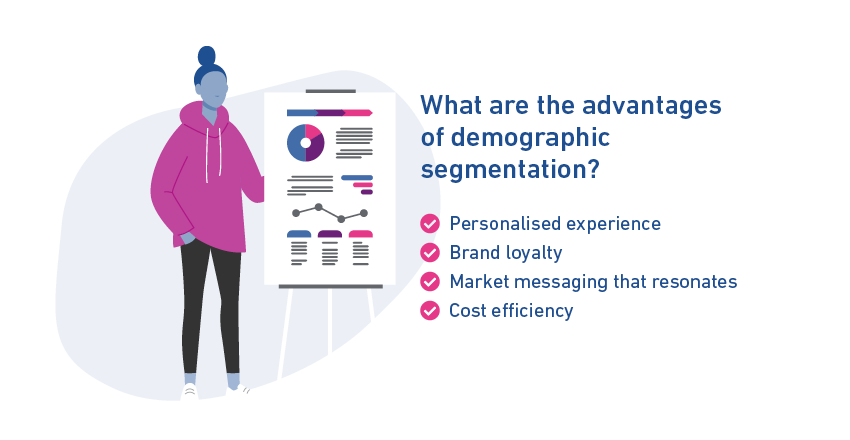What is demographic segmentation?
Demographic market segmentation is grouping consumers based on aggregated demographic characteristics that they share. The characteristics typically included are age, income, gender, occupation, nationality, marital status, and family size.
In marketing, success isn’t about casting the widest net – it’s about precision. It’s not enough to have a great product or service; you must tailor it to resonate with those who truly need or desire it. And the first step is understanding how to do that by getting to know them – this is the crux of demographic segmentation.
What is demographic segmentation?
Demographic market segmentation is grouping consumers based on aggregated demographic characteristics that they share. The characteristics typically included are age, income, gender, occupation, nationality, marital status, and family size.
This data will help you better understand your audience and, by segmenting your target audience into smaller groups that share certain characteristics, you can create targeted marketing campaigns that get better results.
Demographic segmentation is one of the key types of segmentation. Others include geographic segmentation, behavioural segmentation and attitudinal segmentation.
Types of demographic segmentation
Businesses use various factors to categorise their consumers. Here are some of the most popular demographic characteristics used to segment target audiences, and how they can help your business:
Socio-demographic segmentation
This approach combines both social and demographic factors to categorise consumers. Variables such as education level, social class, marital status and family size are often considered.
For example, a luxury car brand would be likely to use this type of segmentation to target consumers that fit within higher social status and income categories so that the results of their efforts are maximised.
Occupation segmentation
Segmenting by occupation means grouping individuals based on their profession or job type, this can be very handy when it comes to creating products or services for specific industries.
For instance, a software company may use occupational segmentation to target distinct industries, creating versions of their software tailored to different industries, such as retail, finance, and healthcare sectors.
Age segmentation
Age is a key demographic variable. Marketers use age-based segmentation to target different age groups and their distinct needs and preferences. Different age groups, for example boomers, millennials, and generation z, all interact with platforms in different ways. Even the vocabulary used changes drastically between groups, despite them speaking the same language.
If you’re marketing to Gen Z, for example, you may want to target them over TikTok as opposed to Facebook.
Income segmentation
Income plays a crucial role in consumer behaviour and buying habits; therefore, income-based segmentation is a popular type of demographic segmentation. A brand needs to know the income range of its audience so that it can market its product or service to the right people; it’s why luxury brands target high-income individuals.
The same goes for targeting lower-income consumers who may respond better to campaigns focussed on cost-effectiveness and long-term quality.
Gender segmentation
Gender is another influential demographic variable. Businesses often tailor their products or services to specific genders – think cosmetic brands and the difference between their product lines for men and women.
When it’s done well, this kind of targeting can be incredibly useful. However, when using gender-based segmentation marketers must avoid basing their messages on stereotypes.
Family role segmentation
Family structure can be an extremely influential factor when it comes to buyer behaviour – think about how your family’s spending habits would have changed throughout the years that you grew up.
A family with multiple teenage children will have different needs to an older couple who have adult children, single people spend differently to those in a couple, and so on. Marketers need to understand these structures and what happens when there are changes within them, as these elements hugely affect a family’s consumption pattern.

What are the advantages of demographic segmentation?
Demographic segmentation offers many advantages for businesses seeking to communicate and connect with their target audience more effectively. Here are some of the ones we think are the biggest:
Personalised experience
Demographic segmentation allows you to personalise your messaging and experiences to the individual needs and interests of your customers, therefore better meeting their wants and needs. This can lead to increased customer engagement and conversions, improved customer satisfaction, customer loyalty, reduced churn, and increased revenue.
Brand loyalty
When a brand takes the time to work out how to meet the consumer’s needs, the result is that the customer feels valued and understood. Better customer satisfaction means longer-term relationships with consumers, more return purchases and a higher level of brand loyalty and customer retention.
Market messaging that resonates
Segmenting your market demographically can help you to sell the same thing to different audiences, just as successfully. For example, selling a bicycle to people within entirely different family structures: you can emphasise the safety and durability aspects of the bike when you market to parents while emphasising the lifestyle benefits of a bike to single people or couples.
Cost efficiency
With demographic data, you’ll know who will respond to which kind of message. This saves you money by reducing the resources being spent on uninterested consumers or campaigns that don’t speak to your audience.

Are there any disadvantages of demographic segmentation?
As with everything, demographic segmentation can have its drawbacks. It’s important to take them into account when segmenting data so you can do your best to mitigate them.
Overlooking individuality
Relying on demographic data alone can lead to generalisations. It can mean businesses overlook certain preferences and behaviours within segments. Further, as we mentioned earlier, there’s a risk of stereotyping when using this kind of data. Without due care, this can lead to negative customer perceptions.
Changing demographics
This type of data is not static. People’s situations, preferences, and characteristics change over time, meaning it’s necessary to consistently update your data and marketing strategies to reap the best benefits.
Complexity
Managing various demographic segments can be complicated and resource intensive. It requires a lot of market research, data analysis, and diligent segmentation strategies.
Examples of demographic segmentation
There are some real-world champions at utilising demographic data for successful market segmentation. Here are a couple that we think do a stellar job:
- Retail: H&M
H&M is just one example of a company that uses the consumer’s date of birth to segment them and offer birthday discounts[1]. It allows them to send personalised emails without seeming pushy. This approach not only enhances customer engagement through a personal touch but may also increase sales by incentivising purchases with special offers.
- Feminine Care: Always
The #LikeAGirl campaign by feminine care brand, Always, effectively targeted young women by challenging and redefining societal perceptions around doing things “like a girl”[2]. By addressing the self-esteem drop many girls experience during puberty, Always not only reinforced its brand identity but also struck a deep emotional chord with its core audience, driving both social change and brand loyalty. This campaign demonstrates the power of demographic segmentation in creating meaningful and socially relevant marketing messages that resonate strongly with a specific age group and gender, fostering a strong brand connection.
Firmographic vs demographic segmentation
While firmographic and demographic segmentation are both used to categorise and better understand target groups, there are key differences.
Firmographic segmentation categorises businesses and organisations, collecting data and characteristics on a company’s industry, size, revenue, and location. It’s an invaluable approach for B2B companies aiming to identify potential clients.
Demographic segmentation divides a market based on individual characteristics like age, gender, income, education, and ethnicity. It’s commonly used in B2C marketing to tailor products and campaigns to consumers.
While demographic segmentation seeks to understand personal consumer behaviours and preferences, firmographic segmentation focuses on understanding business characteristics and needs, facilitating more targeted B2B marketing strategies.
Demographic segmentation is an incredibly powerful marketing tool. It’s how you get to know and connect to your audience, improve consumer relationships, and increase conversion rates. It is, however, essential to be aware of its limitations as well as its advantages and to use it judiciously. And demographic data is just one segmentation variable in marketing – understanding your consumer can include collating psychographic, behavioural and geographic data for a holistic understanding of your audience.
How can we help?
Our proven approach to segmentation development combines our breadth of market leading demographic and classification data, but also draws on rich first party data and relevant attitudinal insights to create a truly bespoke solution.
As with our Mosaic classification, our demographic segmentations can be linked to every adult / household in the UK with a multitude of use cases including CRM, new customer acquisition and market sizing.
 | Underpinned by our class-leading Mosaic classification |
|---|---|
 | Applicable to both customer and non-customer populations |
 | Incorporates insights across demographic, behavioural and attitudinal data |
 | Can be applied in real-time via API |
 | Can be integrated directly into and influence brand CRM strategy |
Find out more
Our expertise, experience, and data resources empower us to support and facilitate your segmentation project. Whether you seek a deeper understanding of your current customer base or aim to gauge the market size for your offerings, we’re equipped to assist in planning and executing your objectives.
Discover more about audience segmentation and how our expert team can support you to connect to your customers more meaningfully and elevate your business.
[1] Discounts & Offers, H&M
[2] Always #LikeAGirl, Always











